
Journal de l Ecole Polytechnique-Mathematiques
Scope & Guideline
Inspiring Scholars: A Hub for Transformative Mathematical Research.
Introduction
Aims and Scopes
- Algebraic Geometry and Topology:
The journal publishes research on algebraic varieties, their properties, and relationships to topology, including studies on intersection cohomology and mirror symmetry. - Differential Geometry and Geometric Analysis:
Papers often explore geometric structures on manifolds, studying the implications of curvature, symplectic structures, and Riemannian metrics on various mathematical phenomena. - Functional Analysis and PDEs:
A significant portion of the articles focuses on functional analysis, particularly in relation to partial differential equations (PDEs), investigating solutions and the behavior of various operators. - Probability and Stochastic Processes:
Research in this area includes stochastic modeling and analysis, exploring probabilistic behaviors in mathematical systems, particularly in relation to random walks and Markov processes. - Mathematical Physics:
The journal features studies that bridge mathematics and physics, particularly in areas such as quantum mechanics, statistical mechanics, and dynamical systems. - Combinatorial and Discrete Mathematics:
Papers in this domain address combinatorial structures, graph theory, and their applications, contributing to the understanding of discrete mathematical systems.
Trending and Emerging
- Nonlinear Dynamics and Chaos Theory:
Recent publications have highlighted the study of chaotic behaviors in dynamical systems, showing an increased interest in understanding complex systems' stability and unpredictability. - Mathematical Methods in Machine Learning:
The integration of mathematical frameworks with machine learning techniques is gaining traction, as researchers explore optimization, data analysis, and algorithmic efficiency. - Symplectic Geometry and Dynamics:
An increase in interest in symplectic geometry, particularly its applications in dynamics and Hamiltonian systems, reflects a broader trend in mathematics towards understanding the geometrical underpinnings of dynamical systems. - Quantitative Homogenization and Stochastic Analysis:
Papers focusing on quantitative approaches to homogenization theory and stochastic processes have risen, indicating a growing interest in applications of probability in mathematical analysis. - Advanced Algebraic Structures:
Research on advanced topics in algebra, such as derived categories and higher algebra, is increasingly prominent, reflecting ongoing developments in modern algebraic theory.
Declining or Waning
- Classical Number Theory:
Research related to classical problems in number theory has become less prevalent, possibly due to a growing interest in more applied mathematical fields or computational aspects. - Elementary Geometry:
Papers focusing on traditional elementary geometry concepts have decreased, suggesting a move towards more abstract geometric frameworks and higher-dimensional studies. - Algebraic Topology:
Although still relevant, the frequency of articles specifically addressing classical algebraic topology topics has waned, as researchers increasingly explore more complex interactions with algebraic geometry.
Similar Journals

European Journal of Mathematics
Exploring the Depths of Mathematical KnowledgeWelcome to the European Journal of Mathematics, a prominent publication that serves as a vital platform for disseminating high-quality research in the field of mathematics. Published by Springer International Publishing AG, this journal has witnessed significant growth since its inception in 2015 and is recognized for its contributions within the Q2 category of Mathematics (miscellaneous) as per the 2023 rankings. With an ISSN of 2199-675X and an E-ISSN of 2199-6768, the journal aims to foster innovation and collaboration among researchers, professionals, and students alike. Although it operates under a traditional access model, the journal's commitment to advancing mathematical knowledge and applications cannot be overstated. Positioned among the top-tier publications, the European Journal of Mathematics is an essential resource that encourages the exploration of emerging trends and theories in mathematics, making it indispensable for anyone striving to stay at the forefront of this dynamic field.
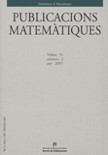
PUBLICACIONS MATEMATIQUES
Illuminating the World of MathematicsPUBLICACIONS MATEMATIQUES is a prestigious academic journal published by Universitat Autònoma de Barcelona, specializing in the diverse field of mathematics and its applications. With an esteemed Q1 ranking in Mathematics (miscellaneous) for 2023, this journal holds a significant position in the mathematical community, reflecting a commitment to high-quality research that spans both theoretical and practical aspects of mathematics. Although it operates without an Open Access model, it remains accessible to a global audience, featuring contributions that range from pure mathematical theories to interdisciplinary applications. Based in Spain, its influence and reach extend internationally, making it a vital resource for researchers, professionals, and students alike who seek to stay informed and engaged with cutting-edge developments in mathematics. The journal's continuous publication since 2002 further underscores its role in advancing mathematical research and fostering scholarly dialogue.
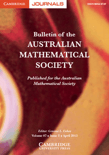
BULLETIN OF THE AUSTRALIAN MATHEMATICAL SOCIETY
Exploring the Depths of Mathematical DiscoveryBULLETIN OF THE AUSTRALIAN MATHEMATICAL SOCIETY is an esteemed journal dedicated to advancing the field of mathematics, published by Cambridge University Press. Since its inception in 1969, this periodical has fostered scholarly communication and showcased pivotal research in various domains of mathematics, now projected to continue until 2024. With an impact factor that places it in the Q2 category of miscellaneous mathematics research, it holds a notable position among its peers, ranking 215th out of 399 in the Scopus database. Though it does not currently offer open access options, the journal remains a vital resource for researchers, professionals, and students seeking to deepen their understanding of mathematical advancements. The Bulletin serves as a crucial platform for disseminating original research, comprehensive reviews, and insightful perspectives that navigate the complexities of mathematics today, ensuring the community is well-informed and engaged.

Pure and Applied Mathematics Quarterly
Shaping the Future of Mathematics with Every IssuePure and Applied Mathematics Quarterly is a prestigious journal published by INT PRESS BOSTON, INC, focusing on the diverse and evolving field of mathematics. Since its inception in 2007, this journal has grown significantly, currently holding a Q1 ranking in the Mathematics (Miscellaneous) category for 2023, positioning it among the leading publications in the discipline. With a commitment to publishing high-quality research, Pure and Applied Mathematics Quarterly fosters innovation and dialogue within the mathematical community by providing a platform for theoretical advancements and practical applications. The journal remains accessible to researchers and professionals through its ISSN 1558-8599 and E-ISSN 1558-8602, although it does not currently offer open access. As a vital resource for mathematicians, educators, and students, this journal endeavors to expand the frontiers of mathematical knowledge and contribute to the academic dialogue surrounding this fundamental science.

CANADIAN JOURNAL OF MATHEMATICS-JOURNAL CANADIEN DE MATHEMATIQUES
Elevating research standards in the world of mathematics.Canadian Journal of Mathematics - Journal Canadien de Mathématiques is a prestigious peer-reviewed journal published by Cambridge University Press, which aims to advance the field of mathematics through the dissemination of high-quality research articles. With its ISSN 0008-414X and E-ISSN 1496-4279, the journal plays a pivotal role in fostering mathematical research and collaboration. It has been recognized for its impactful contributions, currently holding a category quartile ranking of Q2 in Mathematics (miscellaneous) for 2023 and sits in the 66th percentile among its peers according to Scopus rankings. As the journal continues its convergence from its inception in 1994 through to 2024, it remains a vital resource for researchers, professionals, and students seeking to stay at the forefront of mathematical developments. The journal does not operate under an open access model, allowing for a curated collection of articles that adhere to rigorous academic standards.

Tunisian Journal of Mathematics
Connecting Scholars to Shape the Future of Mathematics.Tunisian Journal of Mathematics, an esteemed publication by Mathematical Sciences Publishers, serves as a vital platform for the dissemination of groundbreaking research in the field of mathematics. With an ISSN of 2576-7658 and an E-ISSN of 2576-7666, this journal has quickly established itself since its inception in 2019, evidenced by its impressive Q1 ranking in Mathematics (miscellaneous) for 2023 and Scopus Rank #141 out of 399, positioning it in the 64th percentile among its peers. Dedicated to fostering a vibrant academic community, it invites high-quality contributions that push the boundaries of mathematical theory and practice while advocating open access principles to enhance research visibility and accessibility. Located in Berkeley, California, the journal's editorial board comprises distinguished scholars committed to upholding rigorous peer-review standards, ensuring that only the most relevant and impactful research is published. The Tunisian Journal of Mathematics is not just a journal; it is a cornerstone for researchers, professionals, and students eager to explore the vast and dynamic landscape of mathematics.

JOURNAL OF THE EUROPEAN MATHEMATICAL SOCIETY
Catalyzing Progress in Applied and Theoretical MathematicsThe JOURNAL OF THE EUROPEAN MATHEMATICAL SOCIETY, published by the EUROPEAN MATHEMATICAL SOCIETY (EMS), stands as a premier platform in the field of mathematics, known for its rigorous editorial standards and impactful contributions to both applied and theoretical aspects of the discipline. With a commendable Q1 ranking in both Applied Mathematics and Miscellaneous Mathematics categories, alongside a Scopus rank of 32 out of 399 in General Mathematics, this journal has established itself as a crucial resource for researchers and professionals. Since achieving Open Access status in 2021, it has expanded its reach, making cutting-edge research more accessible to a global audience. With a publication horizon extending from 2002 to 2024 and a dedicated focus on high-quality mathematical scholarship, the journal continues to foster innovation and collaboration within the mathematical community.
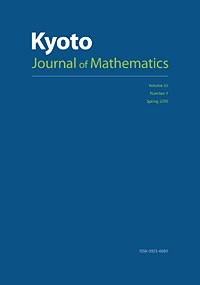
Kyoto Journal of Mathematics
Bridging gaps in knowledge with premier mathematical insights.Kyoto Journal of Mathematics is a premier academic publication dedicated to advancing the field of mathematics, published by DUKE UNIVERSITY PRESS. Established in 1996, this journal serves as a vital platform for sharing innovative research and breakthrough studies across various mathematical disciplines. The journal has consistently maintained a prestigious Q1 ranking in the category of Mathematics (miscellaneous) as of 2023, reflecting its significant impact and contribution to the mathematical community. With its Open Access policy, the Kyoto Journal of Mathematics ensures that groundbreaking research is easily accessible to a global audience, fostering collaboration and knowledge dissemination among researchers, professionals, and students alike. The journal's commitment to excellence and relevance in mathematical research is underscored by its extensive archive of published works and its continuous engagement with contemporary mathematical challenges. This makes the journal an essential resource for anyone seeking to stay abreast of current trends and advancements in the field.
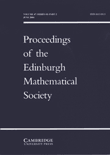
PROCEEDINGS OF THE EDINBURGH MATHEMATICAL SOCIETY
Advancing mathematical frontiers since 1883.PROCEEDINGS OF THE EDINBURGH MATHEMATICAL SOCIETY, published by Cambridge University Press, stands as a cornerstone within the realm of mathematical research, providing a platform for original papers that push the boundaries of various mathematical disciplines. With a rich history dating back to 1883, this journal has evolved through several converged years, reflecting the dynamic nature of mathematical inquiry. As a Q2 category journal in the field of Mathematics (miscellaneous) according to the latest rankings, it situates itself within the upper tier of academic publications, offering an essential resource for researchers and professionals alike. While it currently does not offer open access options, the journal's contributions are invaluable, facilitating dialogue and collaboration among scholars. The journal's commitment to advancing mathematical knowledge makes it a vital publication for those engaged in the study and application of mathematical theories and principles.
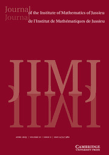
Journal of the Institute of Mathematics of Jussieu
Fostering Collaboration for Tomorrow's Mathematical BreakthroughsJournal of the Institute of Mathematics of Jussieu, published by Cambridge University Press, is a leading academic journal that has established itself as a vital resource in the field of mathematics. With an impressive impact factor and a ranking in the top quartile (Q1) of miscellaneous mathematics, the journal serves as a platform for high-quality research from both established scholars and emerging researchers. Spanning from 2002 to 2024, the journal aims to foster collaboration and innovation in the mathematical community by publishing original research articles, reviews, and critical discussions on a wide range of mathematical topics. Although the journal does not offer open access, it remains widely accessible through various academic institutions and libraries, ensuring that critical advancements in mathematics are shared with a global audience. Located in the United Kingdom at the prestigious Cambridge campus, the journal reflects the rigorous standards of its publisher and the rich academic tradition of its home institution.